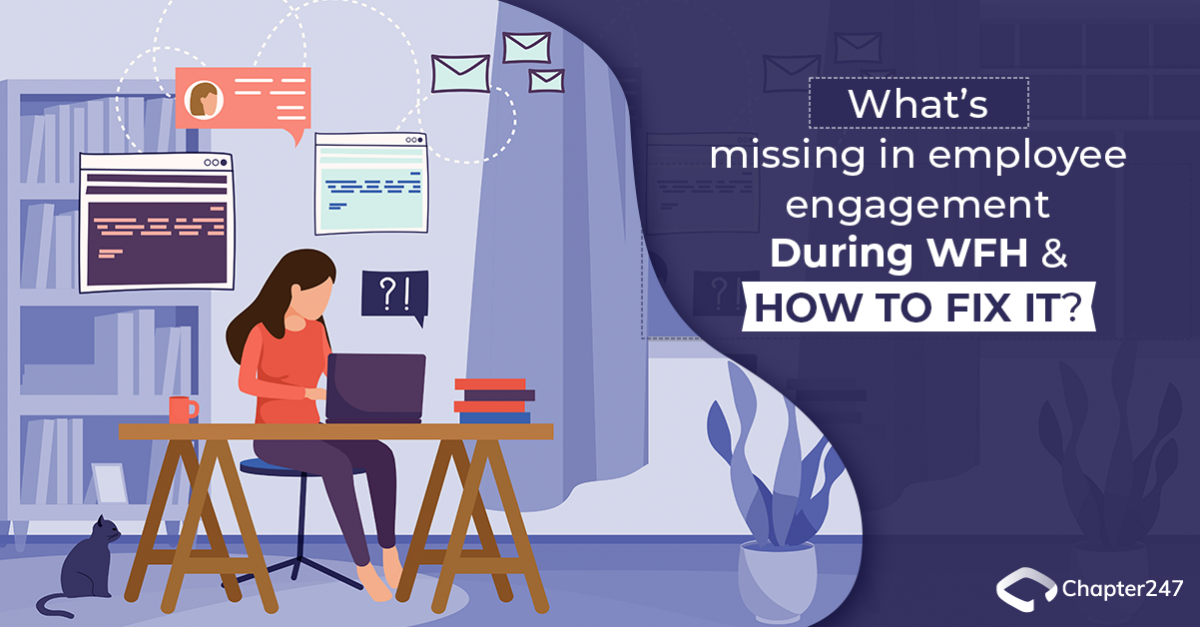It was early in 2020, when companies declared immediate work from home with the rise of Covid-19. We are in 2022, and the culture of work from home (WFH) is still active. With system automations, processes in place and technology crossing all walls WFH is the new trend and is here to stay even post pandemic ends. With virtual offices taking place, and a calendar full of meetings with no coffee-break spaces, we see employees losing out on their productivity. In this blog post, we talk about what is missing in Employee engagements during WFH and what companies can do to fix the same?
What Employees miss during WFH
- Colleagues and office chats
- Hands on involvement in projects, situations & colleagues
- Peace and work focus
- A systematic workplace and office facilities
- Meeting new people / travelling
- Getting out of the ‘bed-couch-shower-kitchen-desk’ circle
- Work-Life balance
- Office Lunches & parties
Some employees miss working from the office because they don’t like the isolation. They need to be with other people and feel like they are contributing to something. Others miss out on the social aspects of working. They can’t make friends, take lunch breaks etc. Some people miss out on the opportunities for creativity and innovation that come from being in a workplace full of ideas and different perspectives. The employees who work from home are more likely to miss work than those who work in the office. This is because they have fewer social interactions and less access to their managers and colleagues. There are no doubts, many benefits to working from home. However, there are also certain drawbacks. One of it being that employees may feel less connected to their company and co-workers. This can lead to a decrease in productivity and a higher turnover rate.
Hybrid working in fashion
There are companies that have initiated Hybrid working in their offices like Google, Facebook etc. Herein they have employees work from home for part of the week and then come into the office on another day of the week. This helps both the employee and companies stay connected with each other and also get time for themselves, as they are coming into the office at least once a week, but still get the benefit of working from home.
A recent study shows that the more time people spend on working remotely, the more they miss their colleagues and the office environment. The main reason for this is that they feel disconnected and isolated. It is not uncommon to find employees who are not present in the workplace because they work from home. This could be because they are trying to save time or money on commuting, but it could also be due to other factors.
Additionally, the use of AI technology in the workplace has increased over the years. As a result, there are now many people who work remotely either full-time or part-time. This means that it is easier for both employers and employees to have people working from home. In these trend changes, companies can pick up some WFH protocols and also drive some creative and engaging activities to motivate and engage employees working from home.

Below are some points which can boost employee engagement and enhance productivity, while driving off the WFH blues:
Remote work playbook
It is always essential to set clear expectations if you want to ensure high engagement and productivity amongst your employees who are working from home. Are your employees clear with what exactly is expected from them while they work from home? To make that clear for your team, you should channelize a remote work policy or so-called “remote work playbook”. This is a guidebook which explains how your company should implement remote work with transparency.
- Working hours: Do you have strict working hours or are you flexible with it? Do you allow your employees to work whenever they want or want at the same time for all? At what time of the day should your employees be available online and on which channels are some questions which need to be clearly called out.
- Regular (online) catch-ups: Are you looking to have some regular daily, weekly or monthly meetings your employees should attend? A set catch-up for quick team meets sharing updates and roadblocks if any.
- Communication channels: What communication channels and tools does your team use? How are they sync with each other? Starting from the online attendance records to the KRA and KPI matching, to appraisals and so on. Do you use different communication channels and tools for different purposes? If yes, this needs to be aligned and employees should be made aware of the same.
- Troubleshooting: In case the employee is facing any device issue or any operational query, who he needs to turn to and how the other department or concerned person can help him should be clearly defended with all the teams for a quick problem solving approach.
Regular check-ins
- Regular check-ins with your employees are extremely important especially when you’re working remotely. These regular check-ins will make sure that the remote teams are on the same page regarding their work duties and tasks assignments. Moreover, these meetings come with an additional value – they will create a sense of togetherness.
- The best practice is to have a daily team morning / evening catch-ups or weekly department catch-ups, weekly coordination meetings and a monthly all-hands meeting. Make sure that the team leaders also keep their regular one-on-one meetings as well. One can choose to have these meetings via video calls or speaking face-to-face on a video call whatever is best for your team.
- However, one needs to make sure that at least some of your check-in meetings done via video conferencing tools have the employee’s cameras ON. Same shall help to strengthen the human connection which is formed by looking someone in the eye and talking face to face, even if it is in the form of a video conferencing.
Virtual Coffee Breaks:
One thing which employees really miss during WFH are the coffee breaks. These breaks not only provide a break from the monotony of work but also are an excuse for a quick chat with the employees. Another way to implement it, is to have virtual coffee breaks. Companies can:
- Schedule these coffee breaks regularly at predictable times
Whether you decide to have your company’s “virtual coffee break” once or twice per day, it has to be predictable. This will make it stick easier and implement smoothly. - Create some ground rules, which shall make these coffee breaks more successful. We can make them completely casual, with no mobiles or email checking but a completely relaxing time to drive off any office stress which gets accumulated during the day.
- Lastly, ensure that employees do gather a cup of coffee, tea or even green tea during the break to actually take their much needed time off at work and get back with higher productivity.
Creative fun based games for employees:
Employees often get overwhelmed by the extensive excel sheet, coding platforms or even the mind exhausting PowerPoint presentations. At such times, it’s highly essential to build and involve employees in some creative building activities which will help their creative juices flow. Engaging activities such as:
- Company culture workshop
- Hackathon
- Online board games
- Quiz content
- Gaming sessions
- Karaoke or a movie night and more
Such activities will not only refresh the employees but also act like an ice-break session with the new employees and strengthen bonds amongst all.
Increase employee learning curve:
It is often seen that employees feel stuck and lose out on their learning curves during WFH as compared to working from the office. However, there are a few good practices that will help your resources to improvise on their learning skills and also start grasping better through online knowledge sharing sessions:
- Enrolling them into a mentoring program
- Watching Webinar together
- Join an online Book club
- Attending Problem-solving workshops & implementing the learning in real-life
- Discussion group
- Monthly presentation or a talk
- Starting Friday, close off meetings to remove employee burnout.
- Acknowledge the work done for the week on Friday evening and celebrate your wins. Also companies must encourage employees to share plans for the weekend with their families or self.
How Chapter247 ensures a healthy engagement for its remote resources?
At Chapter247, with our regular engagement activities, such as Yoga & Meditation sessions, Off-work catch-ups, Up-skilling drives, Training Programs, Recreational Activities and more, we ensure that our employees always feel belongingness and stay far off from burnouts. Want to experience an employee driven healthy work culture? Come Join us and explore the world of opportunities and career growth with a balanced work-life cycle.








